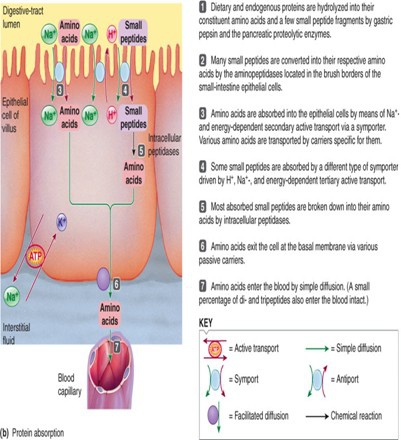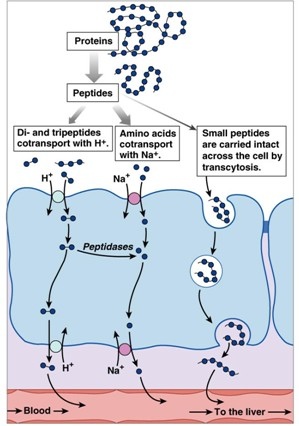Published online 2016 Feb 10. doi: 10.1016/j.bpg.2016.02.007
The daily intake of protein in the western diet averages 100 g per day with an additional 35 g contributed by salivary and GI secretions. Low pH in the stomach activates pepsinogen to pepsin. Pepsin cleaves peptide bonds at the aromatic amino acids, and results in a mixture of intermediate protein moieties, peptides, and amino acids. These are then delivered to the duodenum, where pancreatic proenzymes (trypsinogen, chymotrypsinogen, proelastase, and procarboxypeptidase) become activated by mucosal enterokinase and further breakdown these products into amino acids, dipeptides and tripeptides. The activity of brush border dipeptidases continues to liberate amino acids. However, dipeptides and tripeptides can also enter the enterocyte and then get hydrolyzed by the cytoplasmic peptidases to release amino acids, which then are transported across the BLM of the enterocytes.
Apical Amino Acid Transport Systems
Amino acid transport is complex and there are a number of systems responsible for their uptake across the brush border membrane. They vary in solute specificity, Na+-, Cl−-, H+-, or K+- dependency, and may represent an electroneutral or electrogenic transport process. A summary of amino acid transporters expressed in the human gut is shown in Table 1.
Table 1
Intestinal Amino acid transport systems.
| System | Details |
|---|---|
| B0 | • Na+ dependent transport of neutral l-amino acids (with amino group at α position). |
| • Gene: SLC6A19 Protein: B0AT1 | |
| B0,+ | • Na+ and Cl− dependent transport of neutral and cationic l-amino acids, and certain neutral d-amino acids. |
| • Gene: SLC6A14 Protein: ATB0+ | |
| b0,+ | • Na+ independent transport of neutral and cationic l-amino acids, and cystine. |
| • Genes: SLC7A9 & SLC3A1 Protein: Heterodimer of b0+AT and rBAT | |
| IMINO | • Na+ and Cl− dependent transport of imino acids such as proline, hydroxyproline, and pipecolic acid. |
| • Gene: SLC6A20 Protein: SIT1 | |
| β | • Na+ and Cl− dependent transport of taurine and β-alanine. |
| • Gene: SLC6A6 Protein: TAUT | |
| X−AG | • Na+ and H+ dependent transport of anionic amino acid such as aspartate and glutamate, driven by K+efflux. |
| • Gene: SLC1A1 Protein: EAAC1 | |
| ASC | • Na+ dependent obligatory neutral l-amino acid exchanger with specificity similar to system B0, with preference for alanine, serine, and cysteine. |
| • Gene: SLC1A5 Protein: ASCT2 | |
| N | • Na+ coupled transport of glutamine, asparagine and histidine in exchange for intracellular H+. Present predominantly in intestinal crypts. |
| • Genes: SLC38A3 and SLC38A5 Proteins: SN1 and SN2 | |
| • SN2 is predominantly responsible for the uptake of glutamine across the brush border membrane of intestinal crypt cells. | |
| PAT | • H+ coupled electrogenic transport of short chain amino acids such as glycine, alanine and proline. |
| • Gene: SLC36A1 Protein: PAT1 |
enzyme of protein digestion
Peptide transport
Dipeptides and tripeptides are very efficiently absorbed in the small intestine. The process is indirectly Na+-dependent, in that Na+ is necessary for the activity of Na+/H+ exchanger 3 (NHE3) to generate a proton gradient for H+/peptide co-transport. Thus the two transport processes are functionally coupled. Peptides of four or more amino acids in length are poorly absorbed in a non-carrier-dependent mechanism. The carrier responsible for the intestinal uptake of peptides is known as the peptide transporter 1 (PEPT1). It is encoded by the SLC15A1 gene, and is expressed in the intestinal and, to lesser extent, renal epithelia. PEPT1 is expressed throughout the small intestine and with its high capacity for transport, very little of the dietary peptides escape the terminal ileum. It's expression in the colon is somewhat controversial, though the currently dominant view is that PEPT1 is not expressed in the colon except under certain conditions such as inflammatory bowel disease; and likely as a compensatory response – in short bowel syndrome (SBS). This observation suggests that nutritional formulas containing peptides can be used in clinical conditions where the transport system is expressed. In summary, proteins in the diet and in GI secretions are hydrolyzed initially by gastric pepsin and hydrochloric acid, then by pancreatic proteases and peptidases in the small bowel and cytoplasmic domain of the enterocyte. Therefore, 90% of absorbed dietary proteins is represented in the circulation by amino acids and 10% as dipeptides and tripeptides.
peptide absorption
Basolateral exit of amino acids
Amino acids exit through the BLM of the enterocyte via at least six amino acid transporters. However, depending on the luminal amino acid concentration and cellular demand and on the electrogenic driving forces, these carriers may work in either direction. They form six transport systems: System A – Na+dependent transport of all neutral amino acids and imino acids (SNAT2 carrier encoded by SLC8A2); GLYT1 system – Na+ and Cl− coupled transport of glycine (GLYT1 encoded by SLC6A9). Although bi-directional, GLYT1 primarily transports glycine into the enterocyte, e.g. for glutathione synthesis; y+ – Na+independent transport of cationic amino acids (lysine, arginine, ornithine) (CAT1 encoded by SLC7A1); System L – major Na+-independent transport system for neutral amino acids (excluding imino acids). This transport is mediated primarily by LAT2, encoded SLC7A8, which heterodimerizes with CD98, also known as heavy chain associated with the 4F2 antigen, or 4F2hc; System y+L – although not directly Na+-dependent, forms an obligatory exchange system whereby cellular cationic amino acid is exchanged for the Na+-coupled entry of a neutral amino acid from the blood. System y+L is mediated by two carriers, y+LAT1 and y+LAT2, encoded by SLC7A7 and SLC7A6, respectively. Similarly to system L, y+LAT1 and y+LAT2 proteins heterodimerize with 4F2hc. Lastly, system Asc – Na+-independent transport of short chain amino acids (e.g. glycine, alanine, serine, cysteine, or threonine) – is primarily mediated by the ASC1/4F2hc heterodimer, which also functions as a basolateral amino acid exchanger.










 留言列表
留言列表
 線上藥物查詢
線上藥物查詢 